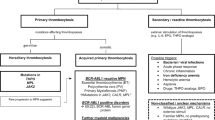Summary
Hypersplenism induced by methylcellulose given to rats i.p. was characterized by splenomegaly, anaemia, leucocytopenia and thrombocytopenia. Hb, Hct and WBC count were normalized, and platelet count rose to supernormal values by splenectomy.
At a standardized liver resection, the hypersplenic rats had an increased blood loss and prolonged bleeding time in comparison with control rats. Removal of the large spleen normalized these abnormalities.
Hypersplenism also shortened APT time and impaired ADP and collagen-induced platelet aggregation, findings not normalized by splenectomy.
Similar content being viewed by others
References
Åberg M, Hedner U, Bergentz S-E (1979) Effect of dextran on factor VIII and platelet function. Ann Surg 189:243–247
Aster RH (1966) Pooling of platelets in the spleen: role in the pathogenesis of hypersplenic thrombocytopenia. J Clin Invest 45:645–657
Bengmark S, Göransson G, Idvall J, Zoucas E (1980) Increased bleeding during liver resection in ethanol-intoxicated rats. Thromb Haemost 43:203–207
Born GVR, Cross MJ (1963) The aggregation of blood platelets. J Physiol 168:178–195
Brabec V, Sebastik V (1974) Survival and sites of sequestration of erythrocytes in normal and “hypersplenic” rats. Physiol Bohemoslov 23:119–127
Butler M, Britton B, Hawkey C, Smith M, Irving M (1976) The coagulation and fibrinolytic response to splenectomy. Surg Gynecol Obstet 142:731–736
Dameshek W (1955) Hypersplenism. Bull New York Acad Med 31:113–136
de Gabriele G, Pennington DG (1967) Physiology of the regulation of platelet production. Br J Haematol 13:202–209
de Gabriele G, Pennington DG (1967) Regulation of platelet production: “hypersplenism” in the experimental animal. Br J Haematol 13:384–393
Dhall DP, McKenzie FN, Arfor KE, Bygdeman S, Matheson NA (1969) The effect of hemorrhage on platelets. Bibl Anat 10:516–518
Doan CA (1949) Hypersplenism. Bull New York Acad Med 25:625–650
Fabri PJ, Metz EN, Nick WV, Zollinger RM (1974) A quarter century with splenectomy. Arch Surg 108:569–575
Giblett ER, Motulsky AG, Casserd F, Houghton B, Finch CA (1956) Studies on the pathogenesis of splenic anemia. Blood 11:1118–1131
Gopal V, Bisno AL (1977) Fulminant pneumococcal infections in “normal” asplenic hosts. Arch Intern Med 137:1526–1530
Haver V, Gear A (1981) Functional fractionation of platelets. J Lab Clin Med 97:187–204
Ikkala E, Kivilaakso E, Hästbacka J (1974) Splenectomy in blood diseases. Ann Clin Res 6:290–299
Jandl JH, Aster RH (1967) Increased splenic pooling and the pathogenesis of hypersplenism. Am J Med Sci 253:383–397
Kampen EJ van, Zijlstra WG (1961) Standardization of hemoglobinometry. Clin Chim Acta 6:538–544
Karpatkin S (1971) Heterogeneity of human platelets. Ser Haematol 4:75–84
Karpatkin S (1978) Heterogeneity of human platelets. Blood 51:307–318
King H, Schumacher HB (1952) Splenic studies. I. Susceptibility to infection after splenectomy performed in infancy. Ann Surg 136:239–242
Leonard AS, Giebink GS, Baesl TJ, Krivit W (1980) The overwhelming postsplenectomy sepsis problem. World J Surg 4:423–432
McClure PD, Ingram CIC, Stacey RC, Glass U, Matchett M (1966) Platelet function tests in thrombocythaemia and thrombocytosis. Br J Haematol 12:478–498
Nagasue N, Inokuchi K, Kobayashi M, Kanashima R (1978) Platelet aggregability after splenectomy in patients with normosplenism and hypersplenism. Am J Surg 136:260–264
Palmer JG, Eichwald EJ, Cartwright GE, Wintrobe MM (1953) The experimental production of splenomegaly, anemia and leukopenia in albino rats. Blood 8:72–80
Peters A, Klonizakis I, Lavender J, Lewis S (1980) Use of 111 Indium-labelled platelets to measure spleen function. Br J Haematol 46:587–593
Proctor RP, Rapaport SI (1961) The partial thromboplastin time with kaolin. Am J Clin Pathol 36:212–219
Robinette CD, Fraumeni JF Jr (1977) Splenectomy and subsequent mortality in veterans of the 1939–45 war. Lancet 2:127–129
Rossi E, Louis G (1977) Kinetic parametres of platelet aggregation as an expression of platelet responsiveness. Thromb Haemost 37:283–290
Singer DB (1973) Postsplenectomy sepsis. In: Rosenberg HS, Bolande RP (eds) Perspectives in pediatric pathology, vol 1. Year Book Medical Publishers, Chicago, pp 285–311
Swank RL (1968) The screen filtration pressure method in platelet research; significance and interpretation. Serum Hematol 1:146–151
Zucker S, Mielke CH (1972) Classification of thrombocytosis based on platelet function tests: correlation with hemorrhagic and thrombotic complications. J Lab Clin Med 80:385–394
Author information
Authors and Affiliations
Additional information
Supported by the Swedish Cancer Society (grant no. 98-B77-13XB77:133)
Rights and permissions
About this article
Cite this article
Alwmark, A., Bengmark, S., Gullstrand, P. et al. Hypersplenism—effect on haemostasis. Res. Exp. Med. 186, 21–27 (1986). https://doi.org/10.1007/BF01851830
Received:
Accepted:
Issue Date:
DOI: https://doi.org/10.1007/BF01851830




